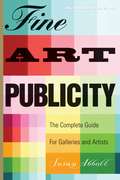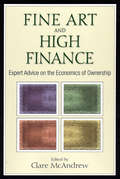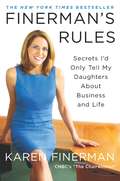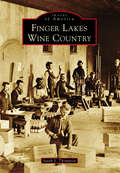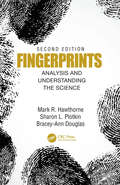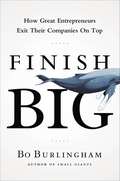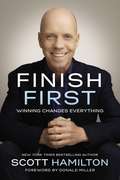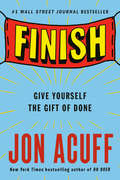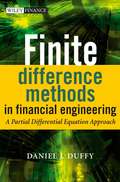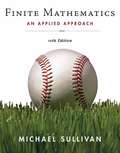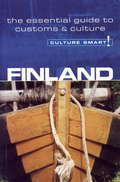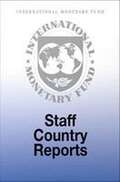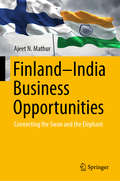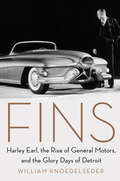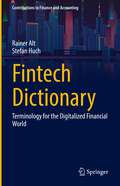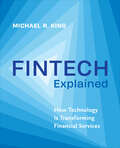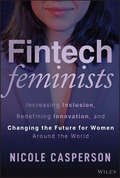- Table View
- List View
Fine Art Publicity: The Complete Guide for Galleries and Artists
by Susan AbbottThis savvy resource helps artists and art professionals generate the publicity that keeps their artwork and business in the public spotlight. Provided are practical tools for attracting the media's attention and building bridges between artists, their galleries, and collectors, and between museums and their audiences. This new edition provides the latest word on new art markets; how to research the Internet, build a Website, and launch e-mail publicity campaigns.
Fine Art and High Finance
by Clare McandrewArt and finance coalesce in the elite world of fine art collecting and investing. Investors and collectors can't protect and profit from their collections without grappling with a range of complex issues like risk, insurance, restoration, and conservation. They require intimate knowledge not only of art but also of finance.Clare McAndrew and a highly qualified team of contributors explain the most difficult financial matters facing art investors. Key topics include:Appraisal and valuationArt as loan collateralSecuritization and taxationInvesting in art fundsInsuranceThe black-market art tradeClare McAndrew has a PhD in economics and is the author of The Art Economy. She is considered a leading expert on the economics of art ownership.
Finerman's Rules: Secrets I'd Only Tell My Daughters About Business and Life
by Karen FinermanKaren Finerman likes to tell people she was raised Calvinist. Or as her mother used to say, "I buy my girls Calvin Klein clothes... Then when they graduate from college, they have to figure out how to pay for them themselves." In order to keep herself in Calvin, Karen went to work on Wall Street. As a woman working in finance she noticed numerous ways that she and her female colleagues sabotaged themselves both professionally and personally. Why were her friends unable to bring the same logic they applied at work to personal decisions? Why did they often let personal baggage undermine them in the office in a way that her male colleagues never did? A classic illustration is that women tend to Poll (Do I look good in these shoes?) rather than Decide, often giving too much weight to the input from a random stranger rather than rely on their own gut. Covering three major topics (Career, Money, Love), Finerman's Rules serves up unvarnished advice about getting ahead in your career, overcoming failure, meeting your ideal mate, and navigating the [cut "cons" add "challenges"] of work-life balance. Most importantly, she offers the reader a crash course in taking control of her financial destiny. Or as Karen puts it, "You wouldn't let a man tell you where to live, how to vote, or what to wear. Then tell me why 80 percent of women have a man in charge of their money?"
Finger Lakes Wine Country (Images of America)
by Sarah ThompsonFor more than 150 years, Finger Lakes Wine Country has played a major role in American wine history. At its heart are the four deepest Finger Lakes, part of a group of 11 long, narrow lakes in central New York. There, nestled among Canandaigua, Keuka, Seneca, and Cayuga Lakes, farmers began planting vineyards in the 1830s. In 1860, the Pleasant Valley Wine Company became America's first bonded winery, turning Keuka Lake into a busy shipping hub for fresh grapes and award-winning champagnes. Other wineries soon followed, as did railroads and basket factories. Early 20th century business was good until Prohibition forced wineries to reinvent themselves. In the 1950s and 1960s, innovators like Charles Fournier, Dr. Konstantin Frank, and Walter S. Taylor experimented with hybrid and European vinifera grape varieties. But by the 1970s, local grape growers faced extinction; it would take a grassroots movement and landmark legislation in 1976 to bring about a Finger Lakes wine renaissance.
Fingerprints: Analysis and Understanding the Science
by Mark R. Hawthorne Sharon L. Plotkin Bracey-Ann DouglasFingerprints: Analysis and Understanding the Science, Second Edition is a thorough update of Mark Hawthorne’s classic written by two professionals with combined experience not only in crime scene investigations but also as court-recognized experts in latent print examination. Designed as a concise text to cover the fundamental techniques and principles of obtaining and analyzing latent fingerprint evidence, the book is laid out and written in an easy to understand format for those front-line professionals collecting and analyzing fingerprint evidence. Over time, the degree of sophistication and education on fingerprints and friction ridge analysis has increased. Ultimately, through scientific study by pioneers in the field, the composition of friction skin soon became evident: that it could be used as a unique identifier of individuals. Now, fingerprints and footprints as unique identifiers—and their use in criminal cases—have become commonplace and an essential component of criminal investigation with most cases involving some component of fingerprint evidence. Divided into two parts, the book begins with the basics of analysis, providing a brief history, systematic methods of identification, fingerprint pattern types and their associated terminologies and current classifications. The second part of the book discusses the identification and presentation of evidence in the courtroom, demonstrating both the traditional, manual method of lifting prints and the newer techniques for automated and live scans. Coverage provides instruction on searching and developing latent prints, storage, and comparison of prints. New to this edition are updated techniques on collecting and preserving fingerprint evidence—including packaging and maintaining chain of custody. More detailed documentation processes, and additional chemical and lifting techniques, are described including use of light sources, latent backing cards and lifting material, casting material, ten print cards, and the enhancement of prints in blood. A discussion of laboratory equipment and comparison tools, the addition of photography techniques, and recent courtroom challenges to fingerprint evidence is also presented. Fingerprints, Second Edition will provide a hands-on, fresh look at the most commonly utilized evidence found at crime scenes: fingerprints. The book will provide law enforcement, crime scene personnel and students just such an opportunity to easily understand and grasp the concepts, and relevant issues, associated with friction skin and fingerprint evidence.
Finish Big
by Bo Burlingham"No two exit experiences are exactly alike. Some people wind up happy with the process and satisfied with the way it turned out while others look back on it as a nightmare. The question I hope to answer in this book is why. What did the people with 'good' exits do differently from those who'd had 'bad' exits?"When pioneering business journalist and Inc. magazine editor at large Bo Burlingham wrote Small Giants, it became an instant classic for its original take on a common business problem--how to handle the pressure to grow.Now Burlingham is back to tackle an even more common problem--how to exit your company well. Sooner or later, all entrepreneurs leave their businesses and all businesses get sold, given away, or liquidated. Whatever your preferred outcome, you need to start planning for it while you still have time and options. The beautiful part is that if you start early enough, the process will lead you to build a better, stronger, more resilient company, as well as one with a higher market value. Unfortunately, most owners don't start early enough--and pay a steep price for their procrastination.Burlingham interviewed dozens of entrepreneurs across a range of industries and identified eight key factors that determine whether owners are happy after leaving their businesses. His book showcases the insights, exit plans, and cautionary tales of entrepreneurs such as Ray Pagano: founder of a leading manufacturer of housings for security cameras. He turned down a bid for his company and instead changed his management style, resulting in a subsequent sale for four times the original offer. Bill Niman: founder of the iconic Niman Ranch, which revolutionized the meat industry. He learned about unhappy exits when he was forced to sell to private equity investors, leaving him with nothing to show for his thirty-five years in business. Gary Hirshberg: founder of organic yogurt pioneer Stonyfield Farm. He pulled off the nearly impossible task of finding a large company that would buy out his 275 small investors at a premium price while letting him retain complete control of the business.Through such stories, Burlingham offers an illuminating and inspirational guide to one of the most stressful, and yet potentially rewarding, processes business owners must go through. And he explores the emotional challenges they face at every step of the way.At the end of the day, owning a business is about more than selling goods and services. It's about making choices that shape your entire life, both professional and personal. Finish Big helps you figure out how to face your future with confidence and be able to someday look back on your journey with pride.
Finish First: Winning Changes Everything
by Scott Hamilton Allison FallonGo for the win! Achieve excellence and be better than you’ve ever been!In his years as a professional ice-skater, Olympic Gold Medalist Scott Hamilton learned to embrace the mind-set of working hard to “beat” the competition. But it seems competition has gotten a bad rap these days. We’ve bought into the belief that it is unfair to participants to rank performance. Yet competition is in fact a good thing because it’s about working toward excellence.Finish First is a wake-up call for business leaders, entrepreneurs, spouses, parents, and even students to stop settling for mediocre and begin to revitalize their intrinsic will to achieve excellence and go for the win. Most of us feel we were made for something more, but we’re often afraid to allow ourselves to be competitive because we think our finishing first might somehow rob others of their chance to shine. This book encourages the hidden potential, the champion within all of us, to come out—which eventually brings our family, marriage, career, business, and the world around us the greatest possible good.
Finish: Give Yourself the Gift of Done
by Jon AcuffYear after year, readers pulled me aside at events and said, “I’ve never had a problem starting. I’ve started a million things, but I never finish them. Why can’t I finish?According to studies, 92 percent of New Year’s resolutions fail. You’ve practically got a better shot at getting into Juilliard to become a ballerina than you do at finishing your goals. For years, I thought my problem was that I didn’t try hard enough. So I started getting up earlier. I drank enough energy drinks to kill a horse. I hired a life coach and ate more superfoods. Nothing worked, although I did develop a pretty nice eyelid tremor from all the caffeine. It was like my eye was waving at you, very, very quickly. Then, while leading a thirty-day online course to help people work on their goals, I learned something surprising: The most effective exercises were not those that pushed people to work harder. The ones that got people to the finish line did just the opposite— they took the pressure off. Why? Because the sneakiest obstacle to meeting your goals is not laziness, but perfectionism. We’re our own worst critics, and if it looks like we’re not going to do something right, we prefer not to do it at all. That’s why we’re most likely to quit on day two, “the day after perfect”—when our results almost always underperform our aspirations. The strategies in this book are counterintuitive and might feel like cheating. But they’re based on studies conducted by a university researcher with hundreds of participants. You might not guess that having more fun, eliminating your secret rules, and choosing something to bomb intentionally works. But the data says otherwise. People who have fun are 43 percent more successful! Imagine if your diet, guitar playing, or small business was 43 percent more successful just by following a few simple principles. If you’re tired of being a chronic starter and want to become a consistent finisher, you have two options: You can continue to beat yourself up and try harder, since this time that will work. Or you can give yourself the gift of done.
Finite Difference Methods in Financial Engineering
by Daniel J. DuffyThe world of quantitative finance (QF) is one of the fastest growing areas of research and its practical applications to derivatives pricing problem. Since the discovery of the famous Black-Scholes equation in the 1970's we have seen a surge in the number of models for a wide range of products such as plain and exotic options, interest rate derivatives, real options and many others. Gone are the days when it was possible to price these derivatives analytically. For most problems we must resort to some kind of approximate method.In this book we employ partial differential equations (PDE) to describe a range of one-factor and multi-factor derivatives products such as plain European and American options, multi-asset options, Asian options, interest rate options and real options. PDE techniques allow us to create a framework for modeling complex and interesting derivatives products. Having defined the PDE problem we then approximate it using the Finite Difference Method (FDM). This method has been used for many application areas such as fluid dynamics, heat transfer, semiconductor simulation and astrophysics, to name just a few. In this book we apply the same techniques to pricing real-life derivative products. We use both traditional (or well-known) methods as well as a number of advanced schemes that are making their way into the QF literature:Crank-Nicolson, exponentially fitted and higher-order schemes for one-factor and multi-factor optionsEarly exercise features and approximation using front-fixing, penalty and variational methodsModelling stochastic volatility models using Splitting methodsCritique of ADI and Crank-Nicolson schemes; when they work and when they don't workModelling jumps using Partial Integro Differential Equations (PIDE)Free and moving boundary value problems in QFIncluded with the book is a CD containing information on how to set up FDM algorithms, how to map these algorithms to C++ as well as several working programs for one-factor and two-factor models. We also provide source code so that you can customize the applications to suit your own needs.
Finite Mathematics for Business, Economics, Life Sciences, and Social Sciences (Thirteenth Edition)
by Raymond A. Barnett Michael R. Ziegler Karl E. ByleenLearn about the math that will help you in many careers and academic disciplines.
Finite Mathematics: An Applied Approach (Tenth edition)
by Michael SullivanThis comprehensive book on finite mathematics covers wide range of topics like linear equations, linear systems, linear programming,basic mathematics of finance, set theory and basic combinatorics, probability and statistics, etc.
Finite Mathematics: For The Managerial, Life, And Social Sciences
by Soo T. TanFINITE MATHEMATICS FOR THE MANAGERIAL, LIFE, AND SOCIAL SCIENCES, Twelfth Edition, is a clear, easy-to-follow text that balances contemporary mathematics applications and the latest technology to help give you the key problem-solving skills you need for your life and career in the 21st century. Real-world applications put math concepts in context and cover topics including social media accounts, corporate fraud, criminal justice, cyber privacy, starting a new job, gas prices, smartphone ownership, mobile ad revenues, and more.
Finland - Culture Smart!
by Terttu LeneyCulture Smart! provides essential information on attitudes, beliefs and behavior in different countries, ensuring that you arrive at your destination aware of basic manners, common courtesies, and sensitive issues. These concise guides tell you what to expect, how to behave, and how to establish a rapport with your hosts. This inside knowledge will enable you to steer clear of embarrassing gaffes and mistakes, feel confident in unfamiliar situations, and develop trust, friendships, and successful business relationships. Culture Smart! offers illuminating insights into the culture and society of a particular country. It will help you to turn your visit-whether on business or for pleasure-into a memorable and enriching experience. Contents include * customs, values, and traditions* historical, religious, and political background* life at home* leisure, social, and cultural life* eating and drinking* do's, don'ts, and taboos* business practices* communication, spoken and unspoken "Culture Smart has come to the rescue of hapless travellers." Sunday Times Travel "... the perfect introduction to the weird, wonderful and downright odd quirks and customs of various countries." Global Travel "...full of fascinating-as well as common-sense-tips to help you avoid embarrassing faux pas." Observer "...as useful as they are entertaining." Easyjet Magazine "...offer glimpses into the psyche of a faraway world." New York Times
Finland and Nokia: Creating the World's Most Competitive Economy
by Michael E. Porter Orjan SolvellFinland, with a special language and culture, has developed as a country in between the west (the Nordic region and Europe) and the east (especially its neighbor Russia). In the 1980s, a process started of moving out of an investment-driven economy into an innovation-driven one. With the collapse of the Soviet Union around 1990, Finland reached a crisis. This case covers policy changes made in the 1990s and how, by 2002, the country had managed to become one of the most competitive in the world. A large part of the success could be attributed to the dynamic telecommunications cluster--especially Nokia, accounting for some 70% to 80% of the cluster exports and the world leader in mobile phones. Nokia also reached a crisis around 1990.
Finland: 2003 Article IV Consultation--Staff Report; Staff Statement; Public Information Notice on the Executive Board Discussion; and Statement by the Executive Director for Finland
by International Monetary FundA report from the International Monetary Fund.
Finland: Report on the Observance of Standards and Codes--FATF Recommendations for Anti-Money Laundering and Combating the Financing of Terrorism
by International Monetary FundA report from the International Monetary Fund.
Finland: Selected Issues
by International Monetary FundA report from the International Monetary Fund.
Finland: Selected Issues
by International Monetary FundA report from the International Monetary Fund.
Finland–India Business Opportunities: Connecting the Swan and the Elephant
by Ajeet N. MathurThis book is about promising collaborative avenues for connecting Finland and India with value propositions for enterprises, consumers and investors worldwide. The book covers institutional and cultural differences and explains the logic of business systems, entry modes, and managerial styles in both countries. It draws on experience of successes and also failures to know what should be done differently. It would also interest policymakers that India’s challenges of planting economic orchards in patches of social desert and Finland’s struggle to preserve a social paradise against pulls and pressures of economic graveyards in Europe are both solvable with attention to complementarities and synergies.“From his long and rich experience of working with Finnish and Indian companies and passionate research at IIM Ahmedabad in India, and Aalto University and University of Tampere in Finland, Professor Mathur has a very deep knowledge of how to do business in both countries. Every company leader who considers starting Finnish-Indian business should read this new book. This valuable book will help companies entering new markets to flourish by building robust sustainable business relations.”- Päivi Leiwo, Chairperson Oilon Oy, Lahti, Finland“This book is a treasure trove of knowledge explaining the business opportunities, policies, cultures, institutions, country trajectories and nuances pertaining to Finland and India. The author has worked in business, government and academia in India and abroad. He has also had a long association with Finland and is able to bring you an insider’s perspective of both countries”- Ambassador Ashok Sharma “The author’s deep insider experience in the two countries enables him make very sharp observations on both sides. This book will definitely help in understanding the cultural differences and making interactions and communications smoother. ”- Iiro Rossi, Managing Director, Holiday Club Resorts, Helsinki“This book is a delightful and important guide for those who want to do business between Finland and India. It brings you the numerous business opportunities which wait to be availed, and highlights the deep understanding of the author of the culture and institutional environment of both countries. Read this book, learn and be surprised!”- Niina Nummela, Vice Dean, Professor of International Business, Turku School of Economics, University of Turku, Finland“This book is a reflection of Ajeet’s penchant for deep research and ability to structure and articulate content. This book will be extremely helpful to those who want to develop Indo-Finnish business relations specifically and international business in general. Sonata is currently engaged with business in Finland”- Srikar Reddy, Managing Director, Sonata Software Limited, Bangalore
Finova Group, Inc. (A)
by Stuart C. Gilson Perry L. FaganFinova Group, a $14 billion commercial finance company, filed for Chapter 11 in early March 2001, in what was one of the largest U.S. bankruptcy filings of all time and the largest corporate bond default since the Great Depression. While in Chapter 11, Finova became the object of a heated bidding contest. Under the final accepted plan of reorganization, "Berkadia" (partnership of Leucadia National Corp. and value-investor Warren Buffet's Bershire Hathaway) sponsored a massive recapitalization of Finova, providing a secured loan of $6 billion to buy out the unsecured bank and bond creditors. In return, Berkadia received 51% of the reorganized company's common stock and control of the board of directors. No development of new business was planned. A number of entities represented in the case, however, believed that the company might have substantial going concern value and were concerned that Berkadia would acquire the company at an artificially low price. During the bankruptcy, a large fraction of Finova's debt and equity claims were purchased by so-called "vulture investors," who hoped to influence the outcome of the case.
Finova Group, Inc. (A)
by Stuart C. Gilson Perry L. FaganFinova Group, a $14 billion commercial finance company, filed for Chapter 11 in early March 2001, in what was one of the largest U.S. bankruptcy filings of all time and the largest corporate bond default since the Great Depression. While in Chapter 11, Finova became the object of a heated bidding contest. Under the final accepted plan of reorganization, "Berkadia" (partnership of Leucadia National Corp. and value-investor Warren Buffet's Bershire Hathaway) sponsored a massive recapitalization of Finova, providing a secured loan of $6 billion to buy out the unsecured bank and bond creditors. In return, Berkadia received 51% of the reorganized company's common stock and control of the board of directors. No development of new business was planned. A number of entities represented in the case, however, believed that the company might have substantial going concern value and were concerned that Berkadia would acquire the company at an artificially low price. During the bankruptcy, a large fraction of Finova's debt and equity claims were purchased by so-called "vulture investors," who hoped to influence the outcome of the case.
Fins: Harley Earl, the Rise of General Motors, and the Glory Days of Detroit
by William KnoedelsederThe New York Times bestselling author of Bitter Brew chronicles the birth and rise to greatness of the American auto industry through the remarkable life of Harley Earl, an eccentric six-foot-five, stuttering visionary who dropped out of college and went on to invent the profession of automobile styling, thereby revolutionized the way cars were made, marketed, and even imagined.Harleys Earl’s story qualifies as a bona fide American family saga. It began in the Michigan pine forest in the years after the Civil War, traveled across the Great Plains on the wooden wheels of a covered wagon, and eventually settled in a dirt road village named Hollywood, California, where young Harley took the skills he learned working in his father’s carriage shop and applied them to designing sleek, racy-looking automobile bodies for the fast crowd in the burgeoning silent movie business.As the 1920s roared with the sound of mass manufacturing, Harley returned to Michigan, where, at GM’s invitation, he introduced art into the rigid mechanics of auto-making. Over the next thirty years, he functioned as a kind of combination Steve Jobs and Tom Ford of his time, redefining the form and function of the country’s premier product. His impact was profound. When he retired as GM’s VP of Styling in 1958, Detroit reigned as the manufacturing capitol of the world and General Motors ranked as the most successful company in the history of business.Knoedelseder tells the story in ways both large and small, weaving the history of the company with the history of Detroit and the Earl family as Fins examines the effect of the automobile on America’s economy, culture, and national psyche.
Fintech Dictionary: Terminology for the Digitalized Financial World (Contributions to Finance and Accounting)
by Stefan Huch Rainer AltFintech Dictionary - What is a blockchain framework? What is crowdlending or an ICO? The Fintech Dictionary helps readers in clarifying key terms that have emerged in the vivid field of financial technology (fintech). It links keywords from banking and insurance, from information technology as well as from innovation management – similar to the „melting pot“ of terms in reality. The collection of over 830 keywords presents the reader concise and up-to-date definitions of terms in an alphabetical order. It should serve students and interested parties from academia and practice alike.
Fintech Explained: How Technology Is Transforming Financial Services
by Michael KingFintech Explained provides a rigorous, accessible introduction to the landscape of fintech. Michael R. King explains the customer focus, innovation strategy, business model, and valuation of leading fintechs in cryptocurrencies and decentralized finance (DeFi), crowdfunding and online lending, robo-advice and digital wealth management, payments and insurtech, digital banking, and bigtech. The book profiles the successes and failures of over thirty high-profile fintechs, combining insights from founders, early-stage investors, financial incumbents, and other stakeholders in this dynamic ecosystem. Combining clear descriptions and case studies with the latest findings from academic research, Fintech Explained provides a complete course for educating undergraduate and graduate students, executives, and interested professionals.
Fintech Feminists: Increasing Inclusion, Redefining Innovation, and Changing the Future for Women Around the World
by Nicole CaspersonInspiring stories and actionable advice from highly successful women in fintech Through a thematic table of contents, Fintech Feminists: Increasing Inclusion, Redefining Innovation, and Changing the Future for Women Around the World takes readers on a journey that unveils the profound impact of the fintech industry on our global economy, fueled by the inspiring stories of women leaders who play an integral role in reshaping the financial landscape. Written by Nicole Casperson, an award-winning journalist and leading figure in the fintech sector, this book delivers actionable strategies and insights to navigate the fintech industry, drive positive change, and contribute to the ongoing transformation of the digital era. In this book, readers will find stories from women such as: Shivani Siroya, Founder and CEO of Tala, showing how she communicated her vision to investors effectively, emphasizing its market potential, social impact, and alignment with emerging industry trends Lule Demmissie, CEO of eToro US, explaining how she successfully navigated corporate environments by building supportive networks and advocating for diversity Sallie Krawcheck, Founder and CEO of Ellevest, revealing negotiation tactics that enable successful women entrepreneurs in fintech to secure funding Fintech Feminists: Increasing Inclusion, Redefining Innovation, and Changing the Future for Women Around the World delivers a roadmap for success to women in fintech, along with all business leaders and entrepreneurs who seek to thrive in an evolving and inclusive financial landscape.
